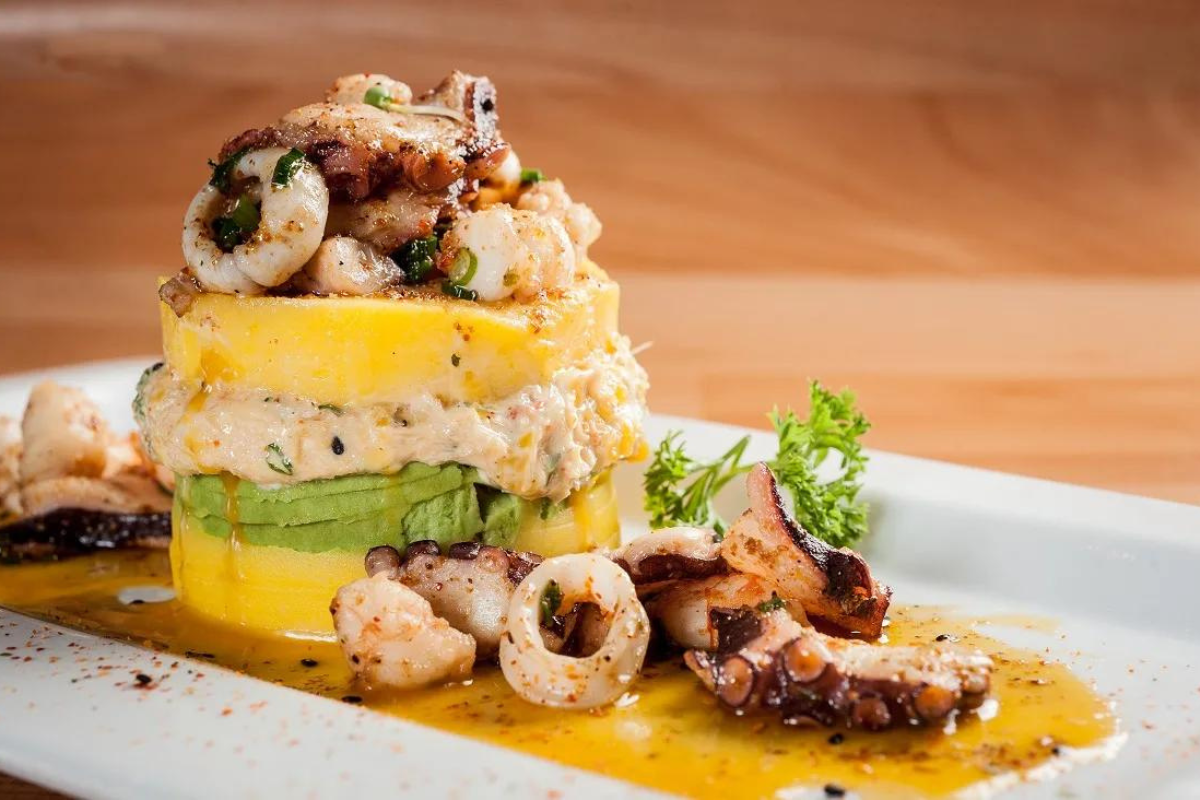Peruvian cuisine is a vibrant tapestry of flavors and influences, reflecting the country’s rich culinary heritage and diverse cultural background. It is a harmonious blend of indigenous Andean traditions, Spanish colonial techniques, and Afro-Peruvian innovations, resulting in a unique and captivating culinary experience.

Photo: Rainforest Cruises
The foundations of Peruvian cuisine can be traced back to the ancient civilizations that thrived in the Andean region. Indigenous ingredients such as potatoes, quinoa, corn, and aji peppers have been staples of Peruvian diets for centuries, forming the basis of traditional dishes like causa, a kind of mashed potato layered with various fillings, or quinoa soup, and anticuchos which are skewered meats marinated in aji peppers.
Peru’s coastal regions were heavily influenced by the arrival of African slaves during the colonial era. Their culinary traditions, particularly from West Africa, introduced ingredients such as plantains, peanuts, and yams, along with spices like cumin and smoked paprika. This fusion gave rise to popular dishes like fried rice and beans called tacu-tacu, caucau that is offal stew with potatoes and spices, and escabeche, which is a kind of fish marinated in a citrus-based sauce.
More recently, Japanese immigration to Peru in the late 19th century led to the emergence of Nikkei cuisine, a unique fusion of Peruvian and Japanese flavors. This culinary exchange resulted in innovative dishes like tiradito, a sashimi-style fish dish with Peruvian sauces, causa rellena, a dish of mashed potato with a Japanese-inspired filling, and Nikkei sushi rolls incorporating Peruvian ingredients like avocado, rocoto peppers, and kiwicha.

Photo: Riko Peruvian Cuisine
A culinary journey: Unveiling the rich tapestry of Peruvian cuisine
Peruvian cuisine is characterized by its bold flavors, vibrant colors, and a harmonious balance of sweet, salty, sour, and spicy elements. Aji peppers, known for their intense heat and complex flavors, are a staple ingredient in Peruvian cooking, adding depth and complexity to dishes. Fresh seafood, particularly from the country’s extensive coastline, is another hallmark of Peruvian cuisine, often prepared in simple yet flavorful ways to highlight its natural sweetness and delicate flavors.
Peruvian cuisine has gained worldwide recognition for its creativity, innovation, and use of fresh, high-quality ingredients. In recent years, Peruvian chefs have been at the forefront of the culinary world, showcasing their unique culinary heritage and inspiring international palates with their inventive dishes.
Peruvian cuisine is a testament to the country’s rich cultural diversity and its ability to adapt and innovate while preserving its culinary traditions. It is a cuisine that is constantly evolving, embracing new influences while staying true to its roots, making it a dynamic and exciting culinary landscape to explore.

Photo: Amigo Foods
Peruvian gastronomy: A culinary fusion, a legacy of exquisite flavors
Peruvian cuisine is a fascinating blend of indigenous Andean traditions, Spanish colonial techniques, and Afro-Peruvian innovations. This culinary heritage has resulted in a vibrant and diverse cuisine known for its bold flavors, fresh ingredients, and skillful preparation.
One of the most iconic Peruvian dishes is ceviche, a refreshing and zesty dish featuring raw seafood marinated in citrus juices, onions, and aji peppers. This dish showcases the Peruvian passion for fresh, high-quality ingredients and the skillful use of spices to create a harmonious balance of flavors.
Lomo saltado, a stir-fried beef dish, is a popular choice among locals and tourists alike. The tender beef is stir-fried with onions, tomatoes, and soy sauce, creating a savory and satisfying dish that is often served with rice and french fries. The contrast between the juicy beef and the crispy potatoes makes this dish a true delight for the palate.
For a comforting and flavorful experience, ají de gallina is a must-try. This creamy yellow chicken stew is made with chicken, aji amarillo sauce, bread, and evaporated milk, creating a rich and satisfying dish that is perfect for a cozy meal. The subtle sweetness of the evaporated milk balances the heat of the aji peppers, making for a truly harmonious culinary experience.
Peruvian cuisine is not complete without its decadent desserts. Suspiro Limeño, a sweet and creamy dessert made with sweetened milk, egg whites, cinnamon, and caramel, is a must-try for any sweet tooth. The silky texture and the harmonious blend of flavors make this dessert a true indulgence for the senses.

Photo: Taste Cocktails
To complement the culinary experience, Pisco Sour, Peru’s national cocktail, is a refreshing blend of pisco, lime juice, sugar, and egg white. The tartness of the lime juice balances the sweetness of the sugar, while the egg white adds a smooth and frothy texture. This cocktail is a perfect way to cap off a delightful Peruvian meal.
Peruvian cuisine is a journey through a rich culinary heritage, offering a kaleidoscope of flavors, textures, and aromas that will leave you wanting more. Embark on this culinary adventure and discover the wonders of Peruvian gastronomy, where every bite is a celebration of tradition, innovation, and passion.

